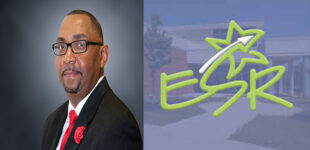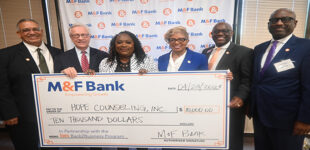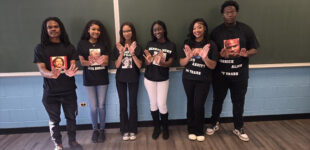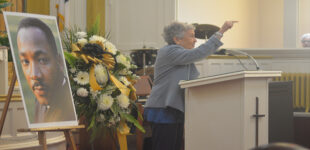Commentary: Art wants to work!
Art in front of the Central Library is called “Timeless Purpose” by Dee Dee Morrison of Birmingham, Alabama. Photo by Todd Luck
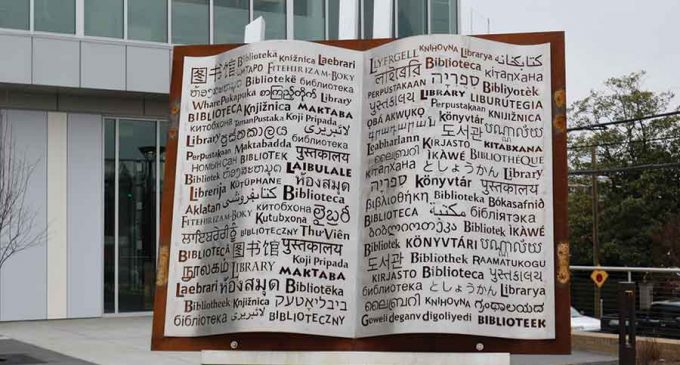
By David Finn
“I am for an art that helps old ladies across the street.”
– Claes Oldenburg (American sculptor, best known for public art that features large replicas of everyday objects.)
I came to Winston-Salem 31 years ago to teach sculpture at Wake Forest. When I first passed the Mickey Coffee Pot driving on Main Street, I had to pull over! What was this? A big, graceful, yet clunky coffee pot? What impressed me was its scale, simple design, and also how it was just stuck on a big ol’ pole. I realized that while it was built as a simple trade sign, the quirky pot has connotations of functionality, modesty, hospitality, and grace – all attributes that I now think describe our community ethos, and deserve to be celebrated – as art!
In 2016 the Winston-Salem City Council and the Forsyth County Board of Commissioners established the 10-member Winston-Salem/Forsyth County Public Art Commission, a working organization responsible for planning public art in the community. The past year saw our first commissions to artists for the County’s new Central Library (“Timeless Purpose” by Dee Dee Morrison of Birmingham, Alabama) and the Benton Convention Center, where we commissioned 11 new works from local and regional artists. The Benton will also be the site for an upcoming commissioned portrait of Larry Leon Hamlin, the influential founder of the National Black Theatre Festival.
The Commission’s goal is to “cultivate innovative, dynamic, and engaging public art that will illuminate the perspectives, relationships, and narratives of our community” and to work with a wide group of citizens and stakeholders to make that happen. In 2018, we will commission the citywide “Winston-Salem Portrait Project” which is envisioned as a complex photographic portrayal of the city, displayed in sites where various communities intersect. The project will be an opportunity for broad participation from a lead artist, local photographers and organizers, and above all citizens of Winston-Salem.
As we move forward to make the ‘City of Arts and Innovation’ a better place, I believe we must simultaneously honor the notable works of art and craft from our past and use them as inspiration for our future. I am thinking of the handmade bricks of George Black, which are everywhere in our city (and motivated the use of brick for the retaining walls on the new Salem Parkway), as well as the traditional bronze statue of Mr. Black by Earline King, another part of this rich legacy. The example of civic engagement set by these artists is now being echoed in a plethora of recent public projects.
The art and design enhancements for the new Salem Parkway will begin to take shape in 2018. The nonprofit Creative Corridors Coalition has worked with the city and state Departments of Transportation to integrate well designed upgrades at a very reasonable cost to the project as a whole. By making bridges, walls and ramps “green, artful, and iconic,” the Parkway communicates the value of beauty that is in fact highly functional. Artivity on the Green, and the Innovation Quarter’s Bailey Park are both recently developed private “art parks” that have a strong public effect, using art and design to enhance spaces, make them memorable, and more accessible. The wonderful lighting events of the Winston-Salem Light Project also deserve mention as one more example of what is called urban “placemaking” – the idea of creating destination areas by layering services, events, and art to create places we all want to be a part of. These innovative art projects all have profound significance in the creation of our forward-looking city.
Including the public in public art is one of the primary goals of the Public Art Commission. We plan to open up the process of how public art is decided on, hold a workshop for local artists to learn about the application process, and create an application open to anyone with an idea. We want to capture the public interest in art and design to help us develop a well-defined plan that can locate future public projects and take advantage of opportunities to add art and design to existing locations such as parks, and greenways, and branch libraries.
Public art and design can enhance physical spaces, but it can also transform how we think of ourselves and our community. Public art can increase communication across the sometimes hidden lines of class, ethnicity and geography and it can temper development with an ethical stance for beauty and inclusivity. As Oldenburg said, art wants to work: by lighting the way, showing you what’s new, knowing your neighbor, making you proud of your city, creating economic development, and, yes, helping you cross the street.
David Finn is chairman of the Winston-Salem Forsyth County Public Art Commission and Professor of Art at Wake Forest University.


